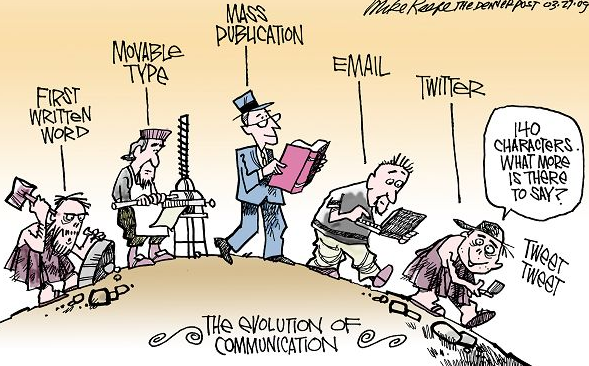I have a tendency to compare technology-based teaching and learning to a favorite cartoon I have posted on my iPad’s lock screen (see below). Much like the chalkboards in my time, I’ve found that sometimes the best and current technologies of the day tend to fade into the background, weaving themselves into the fabric of everyday life until they become indistinguishable from it. Based on that picture, you can see that technology evolves and so our task as educators in the field of technology is to keep up with the times when teaching while at the same time not losing sight of our overall purpose. (sticking to the curriculum, learning, and having fun)
Remember beepers? They were popular in the 90’s but became obsolete by cell phones and therefore few people use paging devices anymore. Therefore why would we want to design a classroom activity around something so old that students can’t relate? New technology is usually old technology in 3-5 years and if we really look at it, new technology usually ends up fulfilling the similar function of the older tech just in a more efficient manner. And so this brings me to the ‘N’ and ‘S’ in Bates and Poole’s SECTIONS framework as I have both good and bad things to say about it. If we, as teachers, end up focusing on constantly keeping current our hardware we will probably find it very frustrating and impossible as school’s or district’s funding will determine how often technology in a school can be updated. After discussing this topic with some of my colleagues, it is obvious that money is a big issue if we subscribe to the theory that new technology is always better for learning. Bates and Poole use phrases like “..how quickly can courses be mounted..”, “..how quickly can courses be changed”, and “…how new is the technology..” forcing me to think and ask the questions: is quick always better and is new always better? Sometimes it is and sometimes it is not. I have experienced both sides of the coin.
Twitter, iPads, Facebook, and texting are all new social trends at the moment for most teens. It would be nice to have iPads for all students and it would be nice if all teachers had new computers (that were trouble free) but budgets and funding don’t seem to dictate that. At the moment, our school has an interactive SmartBoard and/or TeamBoard attached to every teacher computer in the school. This was ‘pushed’ out over the last 2 years to most schools who had the budget to afford it. There was no in-servicing on any of it. The TeamBoards are mounted wrong and the software for them is glitchy. Teachers who were once excited to see the board and new computer in their room are now slightly apathetic because they ended up getting very little support on how to use it and every attempt to try to use it on their part usually ended up with the software crashing or not working correctly. These new and innovative means to teach were pushed out too fast (to meet the new tech trends) without time to properly learn how to teach using it. To some degree, our educators seem to be losing the sight of our overall purpose – learn and have fun. New is not necessarily better and faster is not always a good thing. Bates and Poole put it correctly when stating that “..it can be very dangerous to use leading edge technology that has not been fully tested..”. I think in order for leading edge technology to work effectively you need support and time.
On the other hand, our school has been using a class set of iPads without little support and so students and teachers alike are very excited to sign them out for teaching and learning in the classroom. There seems to be lots of free apps that teachers can use in their subjects and so any teacher who has signed them out has had tremendous success. After an initial training session, teachers got very excited and were able enough to find the app to fit their teachable. With that in mind, after we figured out a reliable wireless infrastructure, teachers are reporting that this new learning medium is everything they were looking for to tap the minds of all students. A good example, for us, on how newer could be better. Therefore, with that in mind, I could not disagree with Bates and Poole enough. Saying that ‘Novelty’ could be the “..least important criterion..”, I believe it could be the most important. Sometimes it takes the newest and most popular tech item to spark interest in students and teachers. On my current staff, I have several teachers nearing their retirement and so this new tech item has sparked a fire under them more than any other time in their teaching career. Students in their class are excited about learning: this has never happened to them before. It doesn’t matter the subject, if you can get a grade 9 and a 59 year old teacher to feel excited about school then “N” is in on my books! And therefore, I’m sure teachers would not have that successful edge in the today’s classroom if they were using older technology and outdated software. Call me crazy!


Leave a Reply